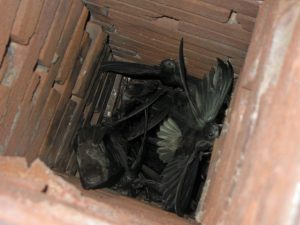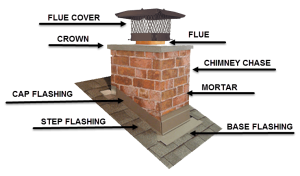How to remove birds nests from your chimney
It’s Spring which means bird nesting season is in full swing. All home and business owners with chimneys should be aware of the annual potential invasion from birds’ looking to take residence. Nests with or without birds living in them can cause various chimney structure problems and are a fire hazard.
Why do birds nest in chimneys?
 Birds seek out chimneys to roost in as in their opinion they are an attractive, safe, dry home; essentially a perfect place to raise their young!
Birds seek out chimneys to roost in as in their opinion they are an attractive, safe, dry home; essentially a perfect place to raise their young!
Jackdaws and barn swallows are the most common birds to nest in chimneys. Swallows in particular hatch in 15 days and the young continue to use the nest for up to three weeks. Meaning it is important to hire a chimney sweep as soon as you suspect nesting is occurring.
How do you know if a bird is nesting in your chimney?
The first sign that you have a bird in the chimney flue is the presence of a few twigs, or other non-chimney materials dropping down into your fire place. This is the stage in which you should give a chimney sweep a call.
Alternatively, you may notice birds flying back and forth around your chimney pot, or you may hear an excessive amount of tweeting or cooing whilst inside or outside your residence.
How do birds build chimney nests?
Birds will find twigs that are just the right width to lodge in the chimney flue. They will gradually build the twig layers upwards similar to a scaffold until they are around six feet from the top of the

chimney; at which point they build the nest. As the nest nears completion it will reach the top of the flue. The bird will then add materials such as horse manure, moss, grass, hair and fur where it plans on laying the eggs. This upper layer often forms a solid dung mass which is hard to break and remove.
You must never try and light a fire whilst there’s a nest in the chimney. This is because you run the risk of smoke entering the room and the twigs igniting – potentially causing a chimney fire. If you have a gas fire, this can be deadly as carbon monoxide could leak into your room and you’ll be none the wiser unless you have a carbon monoxide detector alarm.
What should you do if a bird is actively nesting in your chimney?
Nesting birds are protected by law, under the Wildlife and Countryside Act 1981 which means removing, destroying or tampering with an active nest would be illegal. The act protects eggs, live young, and mothering birds. Consequently, it is key to not let the situation escalate if you suspect a bird may have its eye on your chimney!
If you realise that a bird is nesting late on in their building process chimney sweeps can still be of service as a point of call for advice. They will remove any nests blockages but may have to wait until the end of the breeding season (July onwards.)
What does the nest removal process entail?

Believe it or not nest removal is an extremely physical and time-consuming job. Removing the nest produces a surprising amount of debris which needs to be bagged up and removed. To remove a birds’ nest a small brush is used to puncture the nest, this loosens the nests materials. Next, larger brushes are used to sweep out the remainder of the debris. Lastly, a fire test is conducted by the chimney sweep to ensure that the sweep has been effective.
How can birds be prevented from nesting in chimneys?
Chimney sweeps can fit a bird guarding cap, cage or cowl over your chimney. In the future this will provide ongoing protection from any birds, insects or animals entering your chimney. It is vital to get the chimney cap fitted immediately after the nest removal process. If you leave it 24 hours, the birds may begin to rebuild the nest. Within a very short period a frantic bird may have layered up enough twigs to block the chimney for a second time.
Plus, birds that nest in your chimney are very likely to return again the next year to nest in the same place. Although, it’s worth noting that bird guards need to be chosen with care. They must be made of stainless steel if they are to have any decent lifespan. These can be painted or covered in powder coating to make them look aesthetically pleasing.
Here at ES Sweeps we have over thirty years of chimney sweeping experience and are able to remove any nests left by our feathered friends promptly and professionally. If you have any queries get in touch now on 07545 976 100
Read more of our blogs here.
Installing or reopening a fireplace?
Sufficient room ventilation is a must when installing or considering reopening a fireplace. This is because in order for a fire to properly burn it requires a considerable amount of air. Without this the fire will produce large amounts of Carbon Monoxide which is extremely dangerous. Whilst vents may not be needed in older homes, due to already having sufficient ventilation, modern homes will require this.
Regardless of what fuel your fireplace burns, a vent is required. Fitters will have a range of vents available from simple grills, to more complex ducts. However, it may be a cheaper option to check out your DIY stores first. These vents must not be closable, and the amount of ventilation required must be equal to, or at least 50% of the throat opening to the chimney or flue.
This need not apply if you’re reopening a fireplace, unless extensive building work has been done or the fireplace has been redesigned. All vents new or old must comply with building regulations, proving the vents cannot be blocked, removed or altered. Installers will fit the vents to minimise this and to help prevent noise coming through and drafts.
Quite often, home owners have found their rooms to be colder since having the vents installed. Where you have your vent installed is an important factor to consider when deciding to have a fireplace installed or reopened. If the vent has been installed at ground level away from the fireplace the cold air will not mix with the warmer air already in the room creating the draft.
The ideal place to have your vent fitted would be on the wall next to the fireplace, this is because the cold air coming in from the vent can go straight up the chimney without cooling the room.
Essex & Suffolk sweeps are based in the South Essex area but cover all surrounding areas from woodbridge in Suffolk right through to Kent areas.
For more information contact us
Your London Chimney Sweep
There is nothing more beautiful then having a blazing fire going on those cold days. However, what people aren’t aware of is the safety benefits that a regular London Chimney Sweep can bring to your London home. A lot of London house fires in the past have been caused due to a build-up of creosote in the interior of their Chimney. Creosote is a highly flammable substance which builds up in your Chimney or its liner as a result of burning wood. Something which a good Chimney Sweep can help prevent.
Because of this, homeowners are encouraged to have their Chimney Swept on a regular basis to remove this build-up and protect the house. The frequency of how many times you have your Chimney Swept is dependant upon how often the Chimney is used and what type of fire you have. For example, a wood burner would require more attention due to the build- up of Creosote being a lot higher. Yearly Chimney Sweep inspections should be conducted, despite how often your Chimney is in action. This is because pests can make nests in your Chimney, something which you may not be able to detect, unless you light your Chimney or get a Chimney Sweep inspection.
Chimney Sweep inspections will also ensure that everything is in working order and operating as it should. Our dedicated team can inspect and clean the chimney in your London home, if they decide upon the chimney inspection that it does not require a chimney sweep, they may advise you that they are fine until next time.


